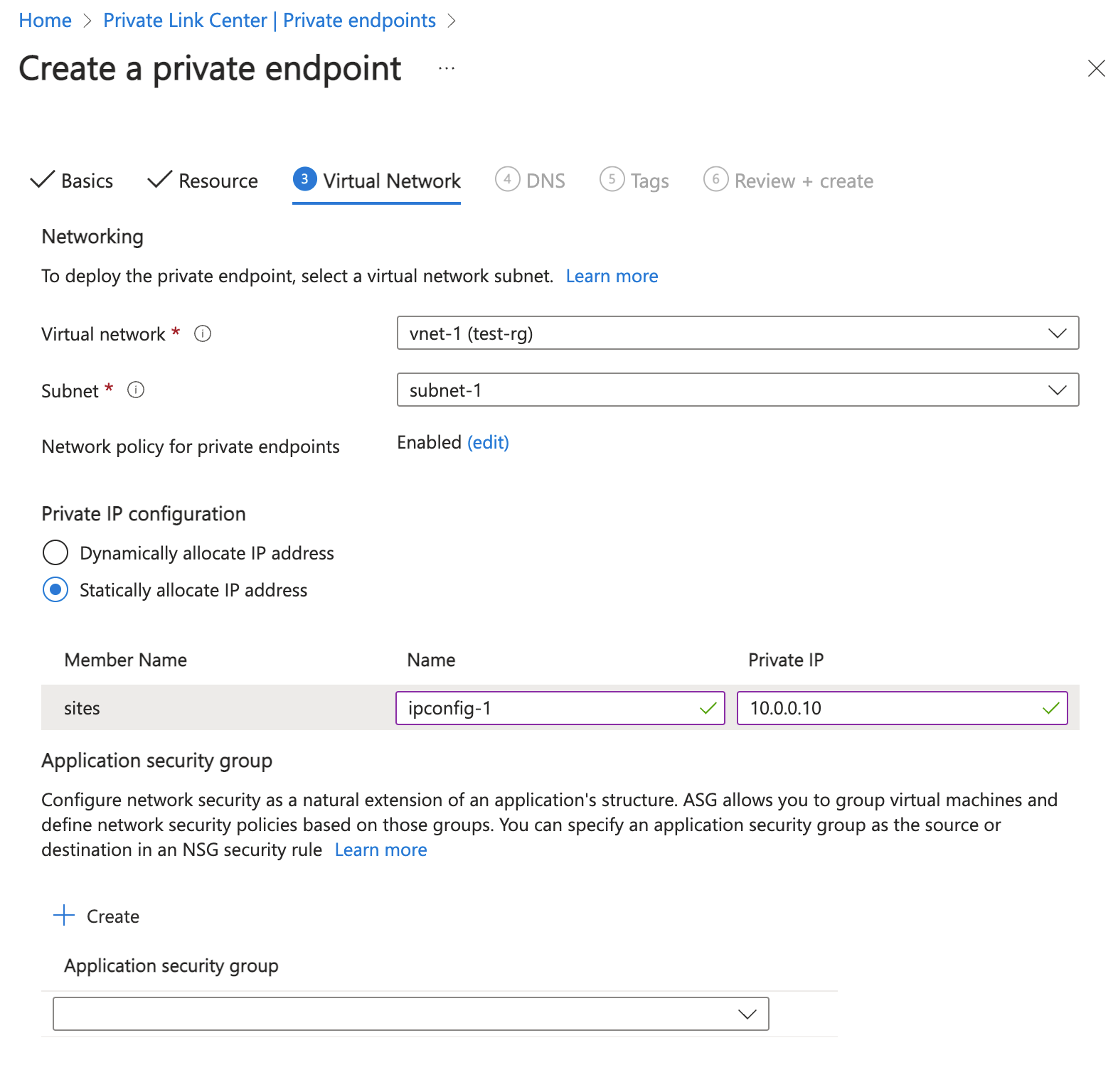Quickstart: Create a private endpoint by using the Azure portal
Get started with Azure Private Link by creating and using a private endpoint to connect securely to an Azure web app.
In this quickstart, create a private endpoint for an Azure App Services web app and then create and deploy a virtual machine (VM) to test the private connection.
You can create private endpoints for various Azure services, such as Azure SQL and Azure Storage.

Prerequisites
An Azure account with an active subscription. If you don't already have an Azure account, create an account for free.
An Azure App Services web app with a Basic, Standard, PremiumV2, PremiumV3, IsolatedV2, Functions Premium (sometimes referred to as the Elastic Premium plan) app service plan, deployed in your Azure subscription.
For more information and an example, see Quickstart: Create an ASP.NET Core web app in Azure.
The example webapp in this article is named webapp-1. Replace the example with your webapp name.
Sign in to Azure
Sign in to the Azure portal.
Create a virtual network and an Azure Bastion host
The following procedure creates a virtual network with a resource subnet, an Azure Bastion subnet, and a Bastion host:
In the portal, search for and select Virtual networks.
On the Virtual networks page, select + Create.
On the Basics tab of Create virtual network, enter or select the following information:
Setting Value Project details Subscription Select your subscription. Resource group Select Create new.
Enter test-rg for the name.
Select OK.Instance details Name Enter vnet-1. Region Select East US 2. 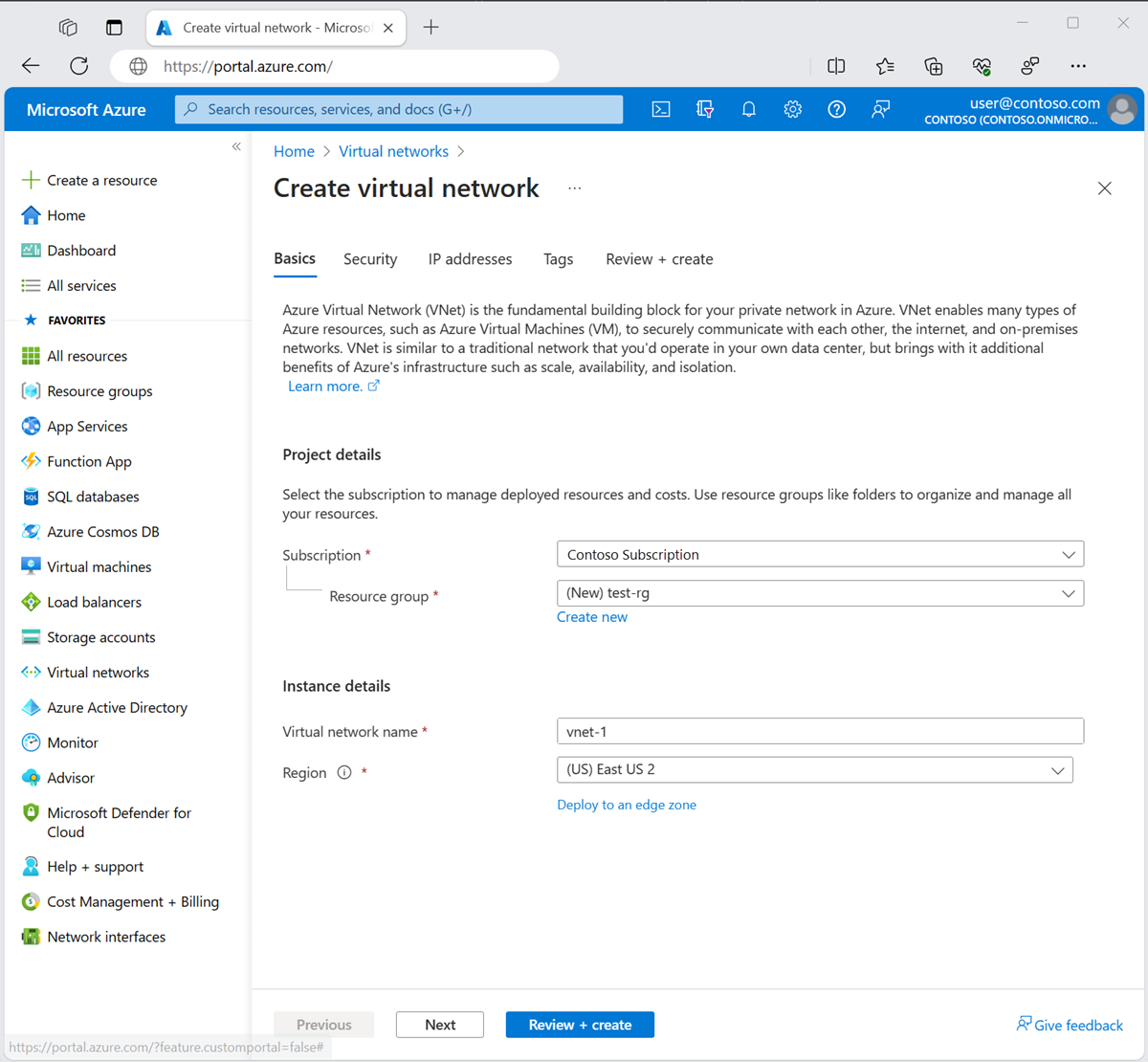
Select Next to proceed to the Security tab.
In the Azure Bastion section, select Enable Bastion.
Bastion uses your browser to connect to VMs in your virtual network over Secure Shell (SSH) or Remote Desktop Protocol (RDP) by using their private IP addresses. The VMs don't need public IP addresses, client software, or special configuration. For more information, see What is Azure Bastion?.
In Azure Bastion, enter or select the following information:
Setting Value Azure Bastion host name Enter bastion. Azure Bastion public IP address Select Create a public IP address.
Enter public-ip-bastion in Name.
Select OK.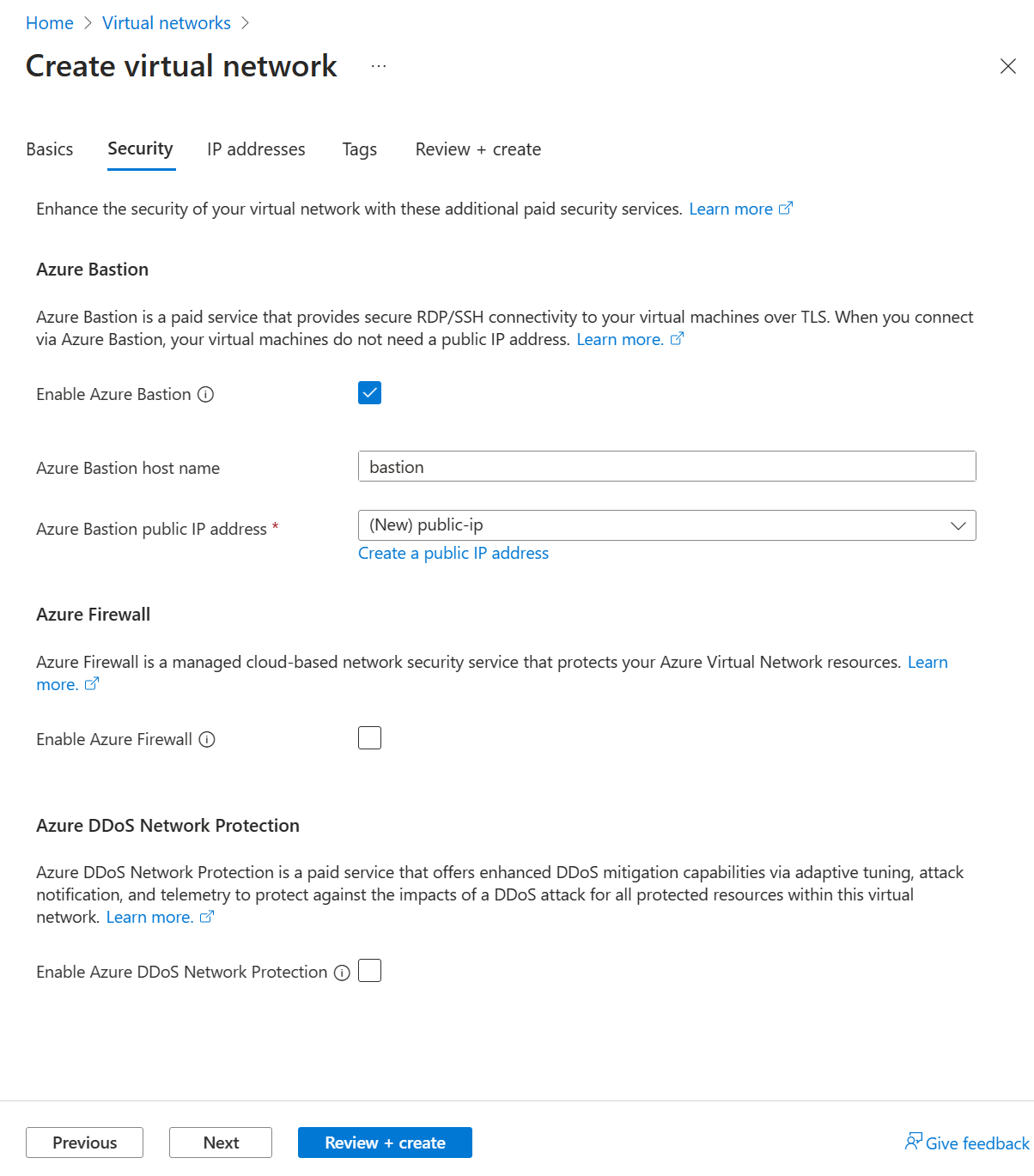
Select Next to proceed to the IP Addresses tab.
In the address space box in Subnets, select the default subnet.
In Edit subnet, enter or select the following information:
Setting Value Subnet details Subnet template Leave the default of Default. Name Enter subnet-1. Starting address Leave the default of 10.0.0.0. Subnet size Leave the default of /24 (256 addresses). 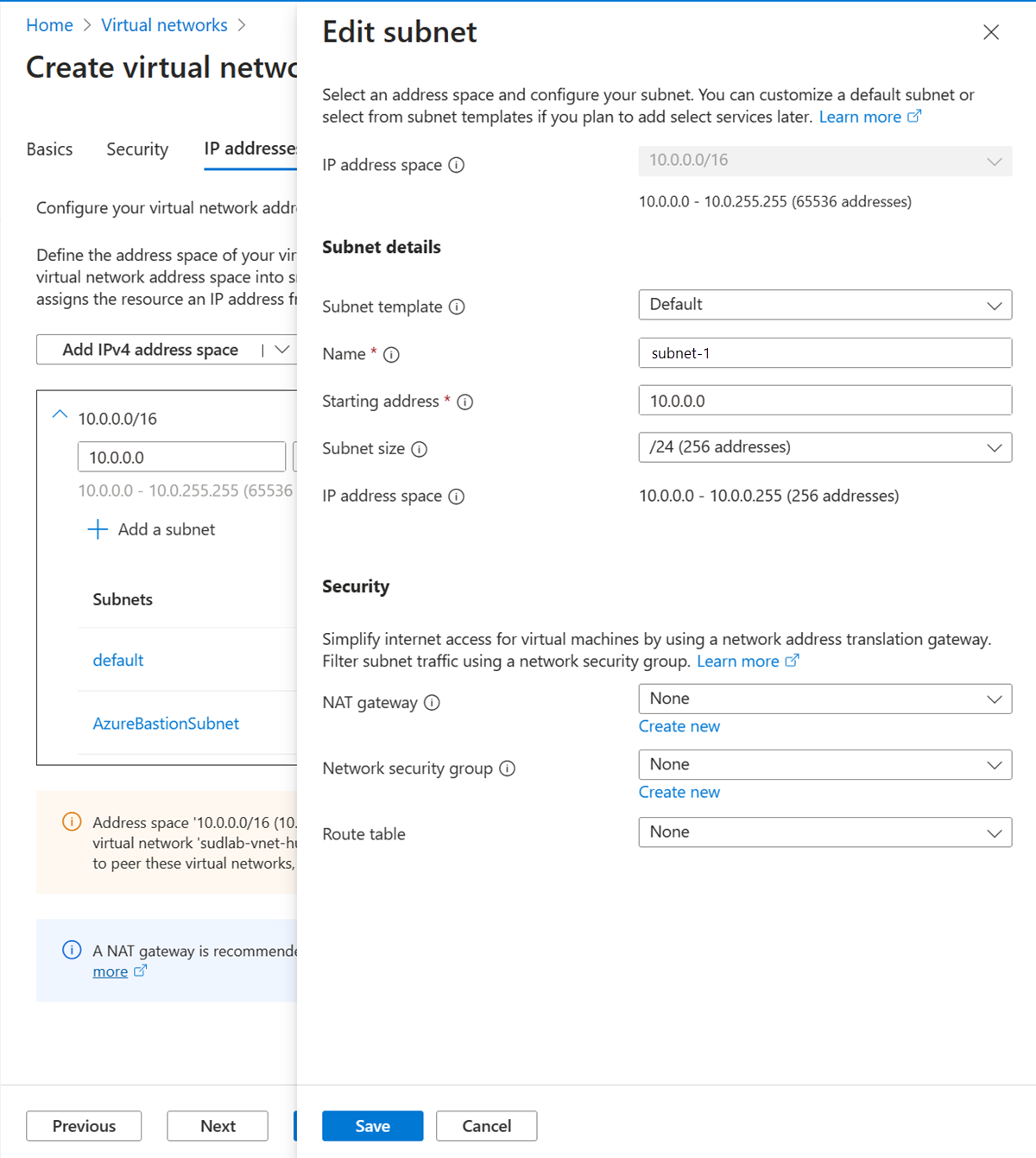
Select Save.
Select Review + create at the bottom of the window. When validation passes, select Create.
Create a private endpoint
Next, you create a private endpoint for the web app that you created in the Prerequisites section.
Important
You must have a previously deployed Azure App Services web app to proceed with the steps in this article. For more information, see Prerequisites .
In the search box at the top of the portal, enter Private endpoint. Select Private endpoints.
Select + Create in Private endpoints.
In the Basics tab of Create a private endpoint, enter or select the following information.
Setting Value Project details Subscription Select your subscription. Resource group Select test-rg Instance details Name Enter private-endpoint. Network Interface Name Leave the default of private-endpoint-nic. Region Select East US 2. Select Next: Resource.
In the Resource pane, enter or select the following information.
Setting Value Connection method Leave the default of Connect to an Azure resource in my directory. Subscription Select your subscription. Resource type Select Microsoft.Web/sites. Resource Select webapp-1. Target subresource Select sites. Select Next: Virtual Network.
In Virtual Network, enter or select the following information.
Setting Value Networking Virtual network Select vnet-1 (test-rg). Subnet Select subnet-1. Network policy for private endpoints Select edit to apply Network policy for private endpoints.
In Edit subnet network policy, select the checkbox next to Network security groups and Route Tables in the Network policies setting for all private endpoints in this subnet pull-down.
Select Save.
For more information, see Manage network policies for private endpointsSetting Value Private IP configuration Select Dynamically allocate IP address. 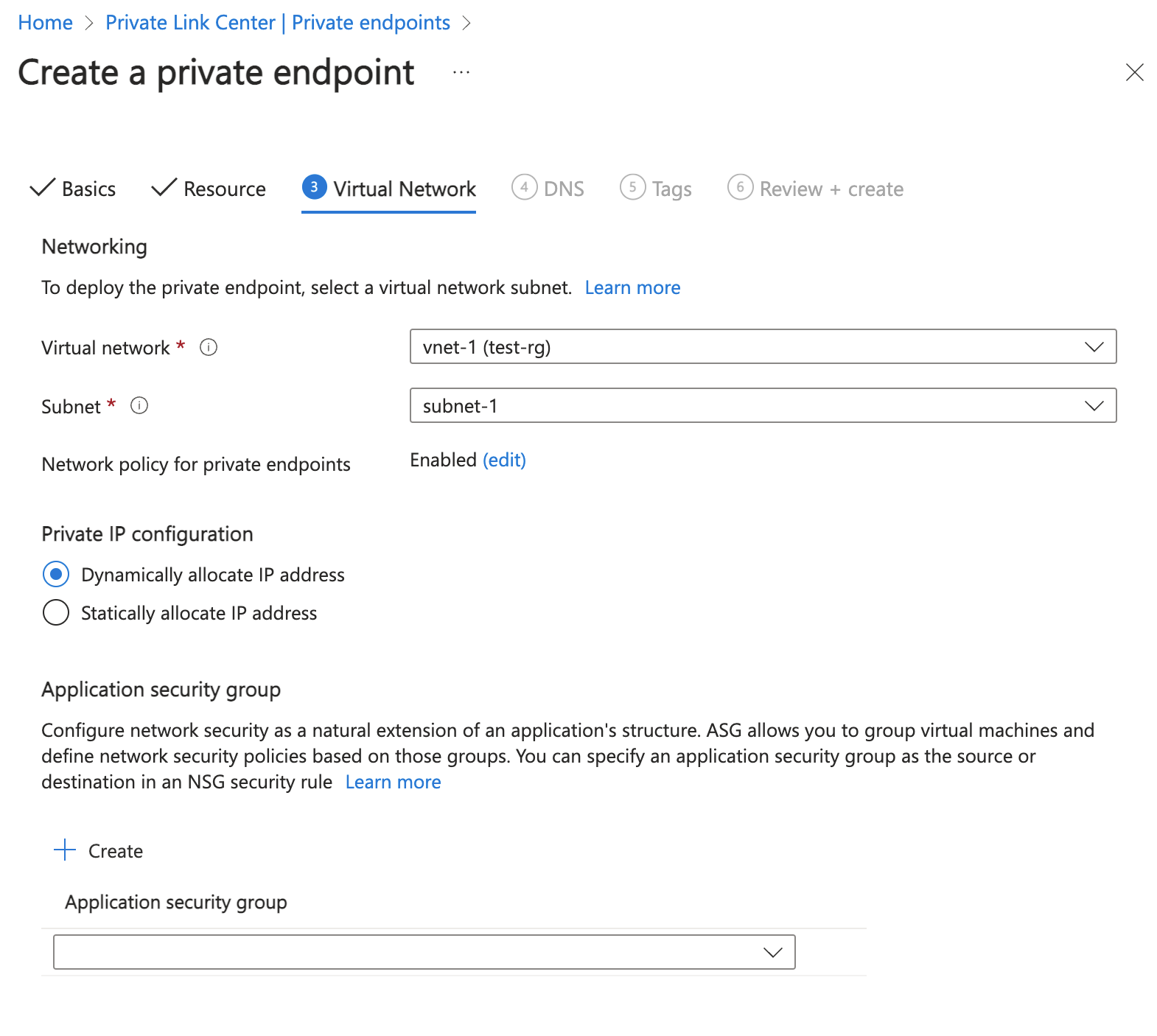
Select Next: DNS.
Leave the defaults in DNS. Select Next: Tags, then Next: Review + create.
Select Create.
Create test virtual machine
The following procedure creates a test virtual machine (VM) named vm-1 in the virtual network.
In the portal, search for and select Virtual machines.
In Virtual machines, select + Create, then Azure virtual machine.
On the Basics tab of Create a virtual machine, enter or select the following information:
Setting Value Project details Subscription Select your subscription. Resource group Select test-rg. Instance details Virtual machine name Enter vm-1. Region Select East US 2. Availability options Select No infrastructure redundancy required. Security type Leave the default of Standard. Image Select Windows Server 2022 Datacenter - x64 Gen2. VM architecture Leave the default of x64. Size Select a size. Administrator account Authentication type Select Password. Username Enter azureuser. Password Enter a password. Confirm password Reenter the password. Inbound port rules Public inbound ports Select None. Select the Networking tab at the top of the page.
Enter or select the following information in the Networking tab:
Setting Value Network interface Virtual network Select vnet-1. Subnet Select subnet-1 (10.0.0.0/24). Public IP Select None. NIC network security group Select Advanced. Configure network security group Select Create new.
Enter nsg-1 for the name.
Leave the rest at the defaults and select OK.Leave the rest of the settings at the defaults and select Review + create.
Review the settings and select Create.
Note
Virtual machines in a virtual network with a bastion host don't need public IP addresses. Bastion provides the public IP, and the VMs use private IPs to communicate within the network. You can remove the public IPs from any VMs in bastion hosted virtual networks. For more information, see Dissociate a public IP address from an Azure VM.
Note
Azure provides a default outbound access IP for VMs that either aren't assigned a public IP address or are in the backend pool of an internal basic Azure load balancer. The default outbound access IP mechanism provides an outbound IP address that isn't configurable.
The default outbound access IP is disabled when one of the following events happens:
- A public IP address is assigned to the VM.
- The VM is placed in the backend pool of a standard load balancer, with or without outbound rules.
- An Azure NAT Gateway resource is assigned to the subnet of the VM.
VMs that you create by using virtual machine scale sets in flexible orchestration mode don't have default outbound access.
For more information about outbound connections in Azure, see Default outbound access in Azure and Use Source Network Address Translation (SNAT) for outbound connections.
Test connectivity to the private endpoint
Use the virtual machine that you created earlier to connect to the web app across the private endpoint.
In the search box at the top of the portal, enter Virtual machine. Select Virtual machines.
Select vm-1.
On the overview page for vm-1, select Connect, and then select the Bastion tab.
Select Use Bastion.
Enter the username and password that you used when you created the VM.
Select Connect.
After you've connected, open PowerShell on the server.
Enter
nslookup webapp-1.azurewebsites.net. You receive a message that's similar to the following example:Server: UnKnown Address: 168.63.129.16 Non-authoritative answer: Name: webapp-1.privatelink.azurewebsites.net Address: 10.0.0.10 Aliases: webapp-1.azurewebsites.netA private IP address of 10.0.0.10 is returned for the web app name if you chose static IP address in the previous steps. This address is in the subnet of the virtual network you created earlier.
In the bastion connection to vm-1, open the web browser.
Enter the URL of your web app,
https://webapp-1.azurewebsites.net.If your web app hasn't been deployed, you get the following default web app page:

Close the connection to vm-1.
Clean up resources
When you finish using the resources that you created, you can delete the resource group and all its resources:
In the Azure portal, search for and select Resource groups.
On the Resource groups page, select the test-rg resource group.
On the test-rg page, select Delete resource group.
Enter test-rg in Enter resource group name to confirm deletion, and then select Delete.
Next steps
In this quickstart, you created:
A virtual network and bastion host
A virtual machine
A private endpoint for an Azure web app
You used the VM to test connectivity to the web app across the private endpoint.
For more information about the services that support private endpoints, see:
Feedback
Coming soon: Throughout 2024 we will be phasing out GitHub Issues as the feedback mechanism for content and replacing it with a new feedback system. For more information see: https://aka.ms/ContentUserFeedback.
Submit and view feedback for
